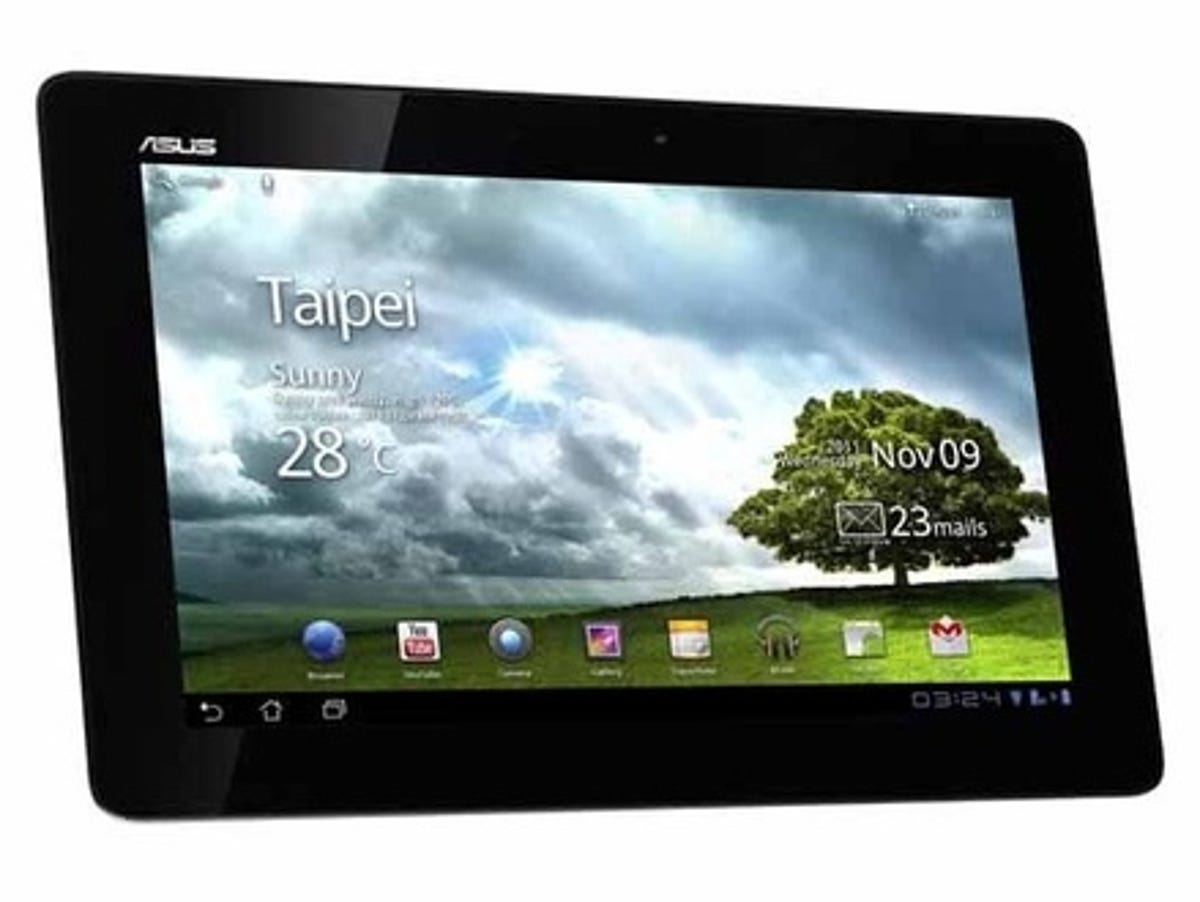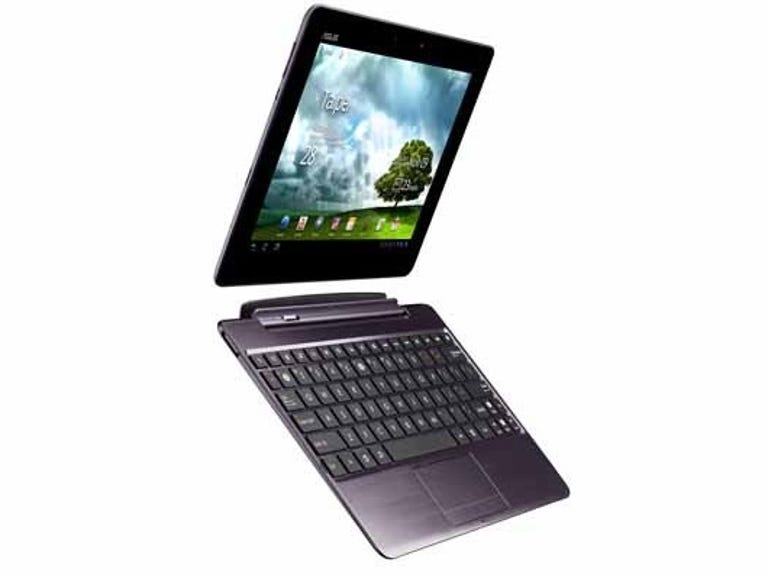 Why You Can Trust CNET
Why You Can Trust CNET Asus Transformer Prime review: Asus Transformer Prime
The Asus Transformer Prime is a powerful tablet and the keyboard dock helps with typing, but its older Android OS is a let-down.
The first Asus Eee Pad Transformer turned quite a few heads with its keyboard dock and sparked numerous debates over whether it's truly a tablet or a laptop.
The Good
The Bad
The Bottom Line
Asus is back again with the Transformer Prime, but has beefed it up with a searingly powerful quad-core Nvidia Tegra 3 processor and 1GB of RAM.
The model we tested was running the older Android 3.2 Honeycomb software, but Asus promises it will be updated to Android 4.0 Ice Cream Sandwich very soon after it goes on sale in the UK. We can only review what's in front of us -- hence our disappointment with the software -- but we'll update this review once the promised update materialises.
The Prime will be available from January for £499.
Tablet design
Like the original Transformer, the Prime is a device of two halves: a 10.1-inch tablet and a keyboard for it to dock into. We're not quite sure if it's more tablet or laptop.
The tablet part is a 10.1-inch affair. An all-metal back makes it feel incredibly sturdy. We poked and squeezed until our fingers hurt and couldn't detect any signs of weakness. We're very confident in the Prime's ability to survive a good road trip.

The casing has a spun-metal finish, very similar to that found on Asus' stunning Zenbook UX21. At only 8.3mm thick, it's very slender, knocking 0.5mm off the iPad's thickness so you'll have no trouble sliding it into a sleeve. It weighs 586g, which marginally undercuts Apple's flagship tablet. You won't feel weighed down when you carry it about.
Around the edges you'll find a 3.5mm headphone jack, a power button, a volume rocker, a micro-HDMI port and a microSD card slot so you can expand the already generous 32GB of storage.
Keyboard dock
If you can't figure out if you'd be better off with a tablet or a laptop, the Transformer Prime is the perfect compromise. If you have to type a few thousand words every now and then for work, a tablet just isn't going to be your friend. As the Transformer's name suggests, you can pop the tablet part into a keyboard dock and set your fingers to work on those financial reports.
Clipping in the tablet requires only a slight push until the clip locks in place. To remove it, flick the switch the other way and pull it out. It's all very simple.
The keyboard itself is 263mm wide -- exactly as wide as the tablet. It weighs 537g, which by itself isn't that much, but it pretty much makes the tablet twice as heavy. You'll end up carrying around a hefty bit of kit when it's all slotted together. The all-metal constuction is responsible for that weight, but it does at least mean that when it's all closed up, the Prime is hunkered down like a frightened armadillo.
The keys are of the square, isolated variety. Although they are spread the whole way across the base, they're still fairly squished up, so they can be awkward to type on. It's about the same size as a netbook's keyboard, so if you can't squash your hands in enough for one of those, you'll struggle to type for too long on the Prime.
The trackpad is rather small, but it supports multi-touch gestures and is easy to swipe your finger across. It's reasonably comfortable to use, but if you're doing lots of scrolling around web pages, you're much better off using your fingers on the screen.
The dock adds a USB 2.0 port so you can pop in an external mouse or game pad as well as an SD card reader, allowing you to expand your storage even more. It also has its own battery, which complements the tablet's own, giving an extra 6 hours of run-time on top of the tablet's 12.
No Ice Cream Sandwich
As Asus' flagship tablet, we'd really expected it to push the boat out on software as much as it has in the construction. Sadly, it hasn't yet loaded it up with the latest version of Android for tablets and phones, Ice Cream Sandwich, but has instead gone for the older Android 3.2 Honeycomb on our review unit.
To the average person in the street, having the latest updates may not be high on their list of priorities. But when you're spending half a grand on something claiming to be absolutely top-of-the-range, it's galling to know that it's already running outdated software, especially when ICS has started to ship on high-end devices like the Samsung Galaxy Nexus.
Asus told us the Prime will be updated "hopefully" some time in January, but that it can't say if any of the tablets sold after that time will ship with the new software. It's clearly a priority for Asus, but if it had waited to send out review units until the software was ready it would have avoided this confusion.
Thankfully though, the Honeycomb experience on the Prime is still a pleasant one. You get five home screens to fill up with apps and live widgets. There's a few widgets provided by Asus, including a handy battery indicator for the tablet and dock. There's also a useful weather widget that shows the weather of your location -- of course, you could just look out of the window and see for yourself.
At the bottom of the screen are the three buttons for navigating around, taking you back, to the home screen, or bringing up a carousel of currently open apps. Any apps you don't want displayed on your home screens are thrown into grids over various pages, similar to iOS home screens on the iPad.
The web browser is clean and simple and supports multi-tabbed browsing, which is handy. The on-screen keyboard is very basic but easy enough to use. Android allows you to download different keyboards, so grab one of those if you don't like the default.
As an Android device, you get full access to the Android App Market, so you can choose from the hundreds of thousands of apps on offer. It's not perfect though and it can be difficult to find apps designed for tablet screens, rather than for smaller smart phones.
The interface isn't exactly stripped down, but it's far from cluttered and it isn't too difficult to get used to, even for those new to Android. A few hours spent playing around with the tablet is sufficient to learn most of the ins and outs and create a very personalised space, replete with widgets, apps and wallpapers.
It's generally pretty pleasant to use, but it's a real shame that it won't ship with Ice Cream Sandwich -- it's likely to be a big drawback for those of you looking to invest your hard-earned cash in a device that's premium in every way. Our fingers are crossed for a speedy update.
Performance
The Prime is the first tablet to hit the shelves packing Nvidia's quad-core Tegra 3 chip running at 1.4GHz. We've only heard the term 'quad-core' bandied around in the laptop world -- and the higher-end laptop spectrum at that -- so we were very excited to see just how much power this thing offers. There's also 1GB of RAM under the hood.
We fired up the CF-Bench test and were given an overall score of 10,764. The Samsung Galaxy S2 managed to achieve just over 6,000 on the same test. Although it's not a tablet, it's a dual-core powerhouse of a phone, capable of running the most demanding of apps, so we're very impressed by how easily the Prime beat this score.
The Samsung Galaxy Tab 10.1 managed around 7,500, so the Prime is clearly storming ahead in the tablet world and showing just what a quad-core processor can do.
Swiping around the home screens was as nippy and responsive as we reckon it's possible to be and apps and menus opened without any delay. Naturally, when you start to load a tablet or phone up with loads of live widgets and apps, you'll notice some slowdown. But the multi-tasking power offered by four cores should keep that to a barely-noticeable minimum.
We tried to slow it down with numerous video streams open in the tabbed browser and various processes running, but still didn't notice any kind of lag when navigating around Honeycomb. We're forced to conclude that this thing is superbly powerful.
That speed also helps when it comes to web browsing, allowing it to render pages faster. The Prime completed the SunSpider JavaScript test with a score of 1,706ms, easily outstripping the iPad 2's time of 2,043ms (a lower number is better) and besting the Galaxy Tab 10.1's time of 2,264ms.
Screen
The Transformer Prime's 10.1-inch screen offers a 1,280x800-pixel resolution, which trumps the iPad 2's 1,024x768 effort. The iPad 3, set to arrive next year, might well beat it. For now though, it's wonderfully sharp, with even small text on web pages displayed in excellent clarity.
It's very bright too, and can be clearly read under bright lights. If you do start to struggle, there's a 'Super IPS' booster button that gives it extra juice, making it almost dangerously bright. If you can't see the screen with that on, it's probably more of an issue with your eyes than the tablet.
The front of the screen is made from Corning Gorilla Glass, which is more resistant to scratches than your run-of-the-mill display.
Camera
On the back of the Prime you'll find an 8-megapixel camera with auto-focus and an LED flash. Cameras on tablets are usually pretty laughable, but no one cares as you're not likely to try any serious photography holding up a 10-inch tablet.
The Prime's camera is far from a joke though. We took it for a run and were very pleased with the results. The auto-focus was quick and mostly accurate and the resultant photos were crisp, clear and had decent colour.
We were very chuffed with the deep red of the pepper as well as the focus achieved on the garlic peel. The wide f2.4 aperture of the lens also allowed an impressive depth of field, so shots look a little more 'arty' than they did on tablets such as the Motorola Xoom 2. Colours are also pretty good when shooting 1080p video, although the focus doesn't seem quite as accurate, but it's great for capturing a quick clip of your dog.
We annoyingly had a few software problems when using the camera -- on several occasions, the picture we had just taken would remain frozen so we couldn't carry on taking pics. At one point, the tablet claimed it was unable to connect to the camera, which was only resolved by turning the tablet off and on again. This grated, but will be easily fixed with software updates.
The camera isn't going to replace your dedicated compact digital -- unless you particularly want to cram a 10-inch tablet into your pocket everywhere you go -- but it's great for taking quick snaps to preserve a moment and share it on Twitter.
There's also a 1.3-megapixel front-facing camera for video calling using applications like Skype.
Conclusion
The Asus Eee Pad Transformer Prime is a superbly powerful tablet that will tackle anything you throw at it with a sly smile. The keyboard dock helps out greatly if you're in the habit of writing long emails.
Sadly, the older version of Android is a big let-down, making it premium in hardware, but not in software. We'll keep our fingers crossed for an update in January.


